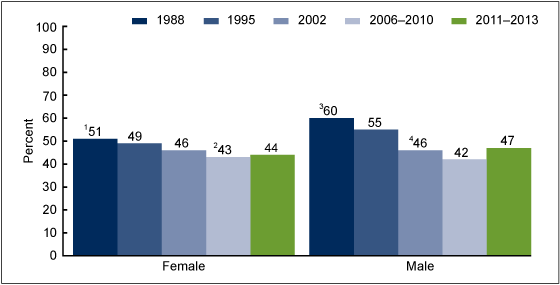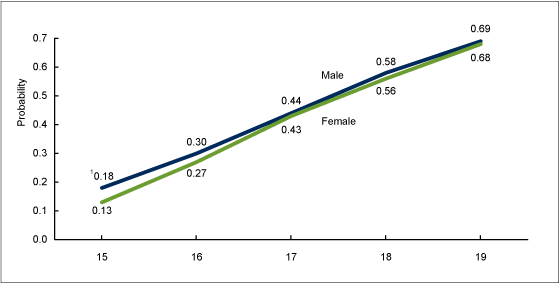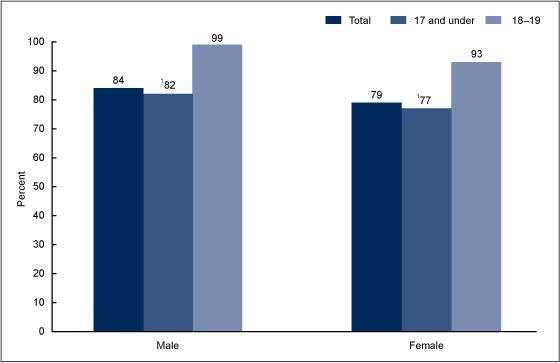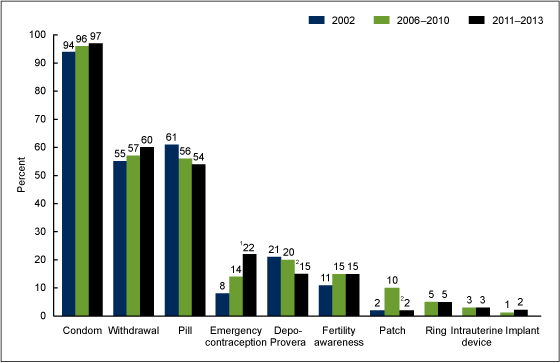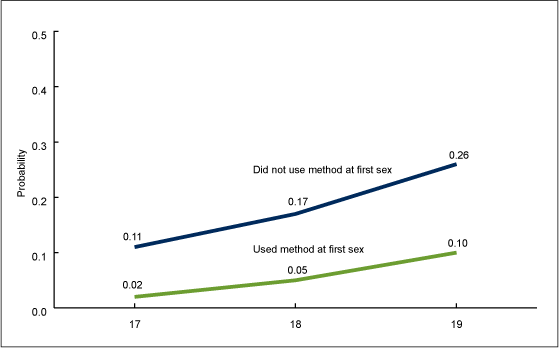Sexual Activity, Contraceptive Use, and Childbearing of Teenagers Aged 15–19 in the United States
NCHS Data Brief No. 209, July 2015
On This Page
- Key findings
- What percentage of teenagers aged 15–19 had sexual intercourse at least once?
- What is the probability of having had sexual intercourse by ages 15–19?
- Did the percentage of teenagers who used contraceptives at first sexual intercourse differ by age at first sexual intercourse?
- How has contraceptive method use changed over the past decade among female teenagers who had sexual intercourse at least once?
- Were female teenagers who didn’t use a method of contraception at first sexual intercourse more likely to have had a birth as a teenager than those who used a method?
- Summary
- Definitions
- Data sources and methods
- About the authors
- References
- Suggested citation
PDF Version (498 KB)
Gladys M. Martinez, Ph.D.; and Joyce C. Abma, Ph.D.
Key findings
Data from the 2011–2013 National Survey of Family Growth
- In 2011–2013, 44% of female teenagers and 47% of male teenagers aged 15–19 had experienced sexual intercourse; the percentage has declined significantly, by 14% for female and 22% for male teenagers, over the past 25 years.
- In the early teen years males were more likely than females to have had sexual intercourse. But the percentage of older teenagers who had sexual intercourse was similar for female and male teenagers.
- In 2011–2013, 79% of female teenagers and 84% of male teenagers used a contraceptive method at first sexual intercourse.
- The condom remained the most common contraceptive method used among teenagers.
- Young women who did not use a method of contraception at first sexual intercourse were twice as likely to become teen mothers as those who used a method.
Monitoring sexual activity and contraceptive use among U.S. adolescents is important for understanding differences in their risk of pregnancy. In 2013, the U.S. birth rate for teenagers aged 15–19 dropped 57% from its peak in 1991 (1), paralleling a decline in the teen pregnancy rate (1–2). But these rates are still higher than those in other developed countries (3–4). Using data from the 1988 to 2011–2013 National Survey of Family Growth (NSFG), this report provides trends and recent national estimates of sexual activity, contraceptive use, and childbearing among teenagers aged 15–19.
Keywords: adolescents, sexual intercourse, contraceptive use at first sex, National Survey of Family Growth
What percentage of teenagers aged 15–19 had sexual intercourse at least once?
- In 2011–2013, 44% of never-married female teenagers (4.3 million) and 47% of never-married male teenagers (4.8 million) had sexual intercourse at least once (Figure 1).
Figure 1. Never-married females and males aged 15–19 who have ever had sexual intercourse: United States, 1988–2013
1The decline in the percentage of female teenagers who had sex at least once from 1988 to 2006–2010 was statistically significant (p < 0.05).
2The difference in the percentages between 2006–2010 and 2011–2013 was not significant.
3The decline in the percentage of male teenagers who had sexual intercourse at least once from 1988 to 2002 was statistically significant (p < 0.05).
4There was no significant change in the percentage between 2002 and 2011–2013.
SOURCES: CDC/NCHS, National Survey of Family Growth, 1988, 1995, 2002, 2006–2010, and 2011–2013. Male data for 1988 and 1995 is from the National Survey of Adolescent Males.
- The percentage of female teenagers who had sex at least once declined 14%, from 51% in 1988 to 43% in 2006–2010. The percentage in 2006–2010 was similar to that in 2011–2013 (44%).
- Among male teenagers, there was a significant linear decline in the percentage who had sexual intercourse at least once between 1988 (60%) and 2002 (46%). However, there was no significant change in the percentage of male teenagers who had sexual intercourse at least once between 2002 and 2011–2013 (46% to 47%).
What is the probability of having had sexual intercourse by ages 15–19?
- In the early teen years (ages 15 and 16) males were more likely than females to have had sexual intercourse (Figure 2). By age 17, the probabilities of having had sexual intercourse were similar for males and females.
- For males, by age 15, 18% had ever had sexual intercourse. By age 17, this percentage increased to 44%, and by age 19, 69% of males had ever had sexual intercourse.
- For females, by age 15, 13% had ever had sexual intercourse. By age 17, this percentage increased to 43%, and by age 19, 68% of females had ever had sexual intercourse.
Figure 2. Probability of having had sex by ages 15, 16, 17, 18, and 19 for males and females: United States, 2011–2013
1Male teenagers have a higher probability of having had sex at each age in teen years compared to female teenagers, except for ages 17 and 19 (p < 0.05).
NOTE: The estimates are based on females and males aged 15–24 at the time of the interview.
SOURCE: CDC/NCHS, National Survey of Family Growth, 2011–2013.
Did the percentage of teenagers who used contraceptives at first sexual intercourse differ by age at first sexual intercourse?
- In 2011–2013, 79% of female teenagers and 84% of male teenagers used a method of contraception the first time they had sexual intercourse (Figure 3). The percentages have not changed over time (data not shown).
- A higher percentage of female teenagers who had first sexual intercourse at ages 18 or 19 used a method of contraception (93%) compared with those who were 17 and under at first sexual intercourse (77%).
- Almost all male teenagers who had first sexual intercourse at ages 18 or 19 used a method of contraception (99%) compared with those who were 17 and under at first sexual intercourse (82%).
Figure 3. Use of contraception at first sex among males and females aged 15–19, by age at first sex: United States, 2011–2013
1Percentage of male and female teenagers aged 17 and under who used contraception at first sex was significantly lower than that of teenagers aged 18–19 (p < 0.05).
SOURCE: CDC/NCHS, National Survey of Family Growth, 2011–2013.
How has contraceptive method use changed over the past decade among female teenagers who had sexual intercourse at least once?
- In 2011–2013, 97% of female teenagers who had sexual intercourse at least once had used the condom at least once (Figure 4).
- In 2011–2013, 60% of female teenagers had ever used withdrawal and 54% had ever used the pill. The differences in pill and withdrawal use between 2002 and 2011–2013 were not statistically significant.
- Use of emergency contraception by female teenagers who had sexual intercourse at least once has increased over the past decade from 8% in 2002 to 22% in 2011–2013.
- Compared with 2006–2010, in 2011–2013, a smaller percentage of female teenagers ever used the patch (from 10% to 2%) and ever used Depo-Provera (from 20% to 15%). As of 2011–2013, approximately 3% of female teenagers who had sexual intercourse at least once had ever used an intrauterine device (IUD), and 2% had used a hormonal implant, similar to the percentages in 2006–2010.
Figure 4. Methods of contraception ever used among females aged 15–19 who had ever had sexual intercourse: United States, 2002, 2006–2010, and 2011–2013
1The percentage of female teenagers who ever used emergency contraception increased in 2006–2010 and in 2011–2013 (p < 0.05).
2Difference in percentage of female teenagers who ever used Depo-Provera or the patch was significantly lower in 2011–2013 than in 2006–2010 (p < 0.05).
NOTES: Neither the contraceptive ring nor the implant were available in 2002. The number of teenagers who had ever used the IUD in 2002 was too small to be statistically reliable.
SOURCE: CDC/NCHS, National Survey of Family Growth, 2002, 2006–2010, and 2011–2013.
Were female teenagers who didn’t use a method of contraception at first sexual intercourse more likely to have had a birth as a teenager than those who used a method?
- By age 17, young women were more than five times as likely to have had a teen birth if they did not use a method of contraception at their first sexual intercourse (11%) than those who used a method (2%) (Figure 5).
- By age 18, young women were more than three times as likely to have had a teen birth if they did not use a method of contraception at their first sexual intercourse (17%) than those who used a method (5%).
- By age 19, young women were more than twice as likely to have had a teen birth if they did not use a method of contraception at their first sexual intercourse (26%) than those who used a method (10%).
Figure 5. Probability of a first birth by ages 17, 18, and 19 for females, by whether they used a method of contraception at first sex: United States, 2011–2013
NOTE: The estimates are based on females aged 15–24 at the time of the interview.
SOURCE: CDC/NCHS, National Survey of Family Growth, 2011–2013.
Summary
This report updates selected indicators of sexual activity, contraceptive use, and childbearing among the teenage population in the United States using the most recent NSFG data available. In addition to costing the public about $9.4 billion a year (5), teen childbearing has negative consequences for the physical, psychological, and economic wellbeing of the young mothers and their children (6–8). The percentage of male and female teenagers who had sexual intercourse at least once has declined in the 25-year period of 1988 to 2013. This decline was greater for male teenagers than female teenagers. According to the most recent data from 2011–2013, by age 19, roughly two of three never-married teenagers have had sexual intercourse. The majority of male and female teenagers used a method of contraception at first sexual intercourse. The methods teenagers most often used were the condom, withdrawal, and the oral contraceptive pill. Female teenagers who used a method of contraception at first sexual intercourse were less likely to have had a birth in their teen years than those who did not use a method of contraception at first intercourse. Understanding these patterns and trends in sexual activity, contraceptive use, and their impact on teen pregnancy can help provide context regarding the recent decline in the U.S. teen birth rate.
Definitions
Age at first sexual intercourse: The recode variable VRY1STAG indicates the respondent’s age at first sexual intercourse, even if it was before a female respondent’s menarche (age at first menstrual period).
Age at first birth: The recode variable AGEBABY1 indicates the female respondent’s age at her first live birth, if any.
Contraceptive methods ever used: These data are based on a series of yes or no questions asking the female respondent if she has ever used each of 19 different contraceptive methods. The following are the contraceptive methods included in this series: the pill; condom; partner’s vasectomy; Depo-Provera injectable; withdrawal; fertility awareness-based methods (e.g., rhythm method or natural family planning); contraceptive patch; contraceptive ring; emergency contraception; hormonal implant; IUD; cervical cap; diaphragm; female condom or vaginal pouch; foam; jelly or cream; suppository or insert; Today sponge; and other method.
Probability of first birth by selected ages: The probability that an individual has had a first birth by various ages was calculated using a life table methodology. This methodology uses age-specific rates to calculate how many individuals of a cohort will experience an event (i.e., first birth) during an interval. The probabilities produced by life table methodology do not represent the actual percentages of individuals who have had a baby by each age shown; instead, they represent how likely it is that an individual will have a baby by a specified age, given the age-specific first birth rates observed for this NSFG-based cohort. For example, a probability of first birth of 0.26 by age 19 means that by age 19 there is a 26% probability that young females will have had a baby.
Probability of first sexual intercourse by selected ages: The probability that an individual has experienced his or her first sexual intercourse by various ages was calculated using a life table methodology. This methodology uses age-specific rates to calculate how many individuals of a cohort will experience an event (i.e., first sexual intercourse) during an interval. The probabilities produced by life table methodology do not represent the actual percentages of individuals who have had sex by each age shown; instead, they represent how likely it is that an individual will have sex by a specified age, given the age-specific first sex rates observed for this NSFG-based cohort. For example, a probability of first sex of 0.78 by age 20 for males means that by age 20 there is a 78% probability that young males will have experienced sex for the first time.
Sexual experience: The recode variable HADSEX indicates whether the respondent ever had vaginal sexual intercourse, referred to in this report simply as sexual intercourse.
Used a contraceptive method at first sexual intercourse: The recode variable SEX1MTHD1 indicates whether any contraceptive method was used at first sexual intercourse, and if so, what method(s).
Data sources and methods
This report is based on data from 1,037 females and 1,088 male teenagers aged 15–19. For Figures 2 and 5, analysis included an additional 960 females and 810 males aged 20–24 interviewed in the 2011–2013 NSFG. These additional cases were included to increase sample size because some teenagers aged 15–19 who have not experienced these events may do so before age 20, and adults aged 20–24 have completed their teen years and can provide information on whether they experienced these events in their teen years. Trends are presented using data from four other data collection periods of NSFG (1988, 1995, 2002, and 2006–2010).
Among other information, NSFG provides detailed information about sexual intercourse, contraceptive use, and the timing of childbearing among U.S. women aged 15–44. The fieldwork plan, interview content, and other procedures of the survey are similar to what was done in previous surveys (9). NSFG is jointly planned and funded by the Centers for Disease Control and Prevention’s (CDC) National Center for Health Statistics and several other programs of the U.S. Department of Health and Human Services. All estimates in this report were weighted to reflect the female and male teenage household population of the United States across the midpoint of 2011–2013 interviewing (July 2012). The response rate for both female and male teenagers in 2011–2013 was 75%.
Statistics for this report were produced using the SURVEY procedures in SAS software version 9.3. The probabilities of first sexual intercourse ( Figure 2) and first birth ( Figure 5) were produced using the PROC LIFETEST procedure in SAS. Percentages were compared using two-tailed t tests at the 5% level. No adjustments were made for multiple comparisons. The data presented in this report are bivariate associations that may be explained by other factors not controlled for in the figures or included in the report.
About the authors
Gladys M. Martinez and Joyce C. Abma are with CDC’s National Center for Health Statistics, Division of Vital Statistics, Reproductive Statistics Branch.
References
- Martin JA, Hamilton BE, Osterman MJK, et al. Births: Final data for 2013. National vital statistics reports; vol 64 no 1. Hyattsville, MD: National Center for Health Statistics. 2015.
- Kost K, Henshaw S. U.S. teenage pregnancies, births and abortions, 2010: National and state trends by age, race and ethnicity. 2014.
- HHS. Healthy People. 2020 topics and objectives: Family planning. Washington, DC.
- CDC. CDC winnable battles 2010–2015: Progress report 2014.
-
The National Campaign to Prevent Teen and Unplanned Pregnancy. Teen childbearing cost taxpayers $9.4 billion in 2010. 2013.
- Jutte DP, Roos NP, Brownell MD, Briggs G, MacWilliam L, Roos LL. The ripples of adolescent motherhood: Social, educational, and medical outcomes for children of teen and prior teen mothers. Acad Pediatr 10(5):293–301. 2010.
- Lee D. The early socioeconomic effects of teenage childbearing: A propensity score matching approach. Demographic Research 23(25):697–736. 2010.
- Hoffman S, Maynard R. Kids having kids: Economic costs and social consequences of teen pregnancy. 2nd edition. Washington, DC: The Urban Institute Press. 2008.
-
Lepkowski JM, Mosher WD, Davis KE, et al. The 2006–2010 National Survey of Family Growth: Sample design and analysis of a continuous survey. National Center for Health Statistics. Vital Health Stat 2(150). 2010.
Suggested citation
Martinez GM, Abma JC. Sexual activity, contraceptive use, and childbearing of teenagers aged 15–19 in the United States. NCHS data brief, no 209. Hyattsville, MD: National Center for Health Statistics. 2015.
Copyright information
All material appearing in this report is in the public domain and may be reproduced or copied without permission; citation as to source, however, is appreciated.
National Center for Health Statistics
Charles J. Rothwell, M.S., M.B.A., Director
Nathaniel Schenker, Ph.D., Deputy Director
Jennifer H. Madans, Ph.D., Associate Director for Science
Division of Vital Statistics
Delton Atkinson, M.P.H., M.P.H., P.M.P., Director
- Page last reviewed: November 6, 2015
- Page last updated: July 22, 2015
- Content source:


 ShareCompartir
ShareCompartir
